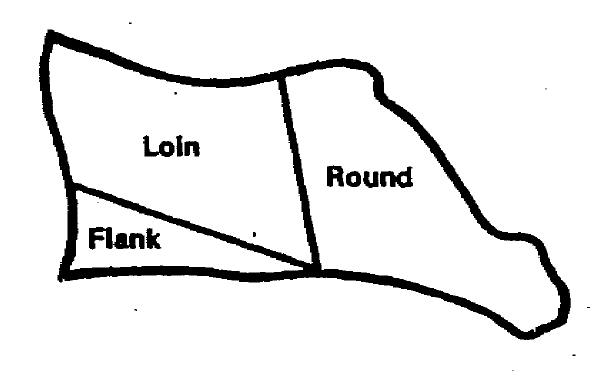
This chart should help you understand that "it's not all meat".
They show the amount of meat to be processed, the weight that the customer can expect to receive, and the percentage of loss through boning, fat removal, and trimmings. These authoritative charts are the results of many cutting test made by meat experts.
Of course, it must be realized by consumers that the size of the animal, the amount of fat, the grade of the meat, and the amount of trimming and boning that is done by the meat processor all affects the percentage of meat that the consumer will receive. This chart can be considered as a guide to give some ideal of the amount of meat to be received.
Expect 130 lbs hindquarter from a 900 lbs heifer or steer. A side from such an animal will weigh about 270 lbs (540 lb carcass).
(Trimmed cuts as usually found at retail)

| Cuts | Weight | Percent |
| T-bones, club steak | 18 lbs | 14% |
| Sirloin steaks, roasts | 16 lbs | 12% |
| Round steaks or roasts | 29 lbs | 22% |
| Rump roasts (boneless) | 8 lbs | 6% |
| Flank steak | 2 lbs | 2% |
| Ground beef | 16 lbs | 12% |
| Meat total | 88 lbs | 68% |
| Bone, fat & trimmings | 42 lbs | 32% |
Enter the cut of meat in which you want Nutritional Information for by clicking in the box below where the word banana is and then click the "Food Search" button. |
Round Cuts --The beef round is one of the true value cuts, since the steaks cut from the round have a high ratio of lean to fat and are tender enough to be broiled. The round can be purchased with the tip included or removed. The tip can be trimmed and become a roast, or it can be sliced the desired thickness into tip steaks by making the cut perpendicular to the direction of the fibers, starting at the large cut surface of the lean. Round steaks may be removed from the round by cutting perpendicular to the round bone at the cut surface. When round steaks have been removed to the large knuckle of the round bone, remove the remaining bone and roll and tie the boneless portion which is the heel of round roast.
This portion can also be cut into cubes for beef stew meat or ground into ground beef. The rump can be boned, rolled, and tied as a boneless rump roast. Shank meat from the round should be converted to ground beef.
Flank Cuts --The flank steak should be removed from the flank and scored on both sides. The fat, connective tissue, and 13th rib should be separated from the lean which can be converted to ground beef.
Loin Cuts --The easiest and most effective way to convert the loin into steaks is to cut to the desired thickness by starting at the large sirloin end. The sequence of cuts that will be created is sirloin, pin bone, porterhouse, T-Bone, and top loin steaks. If any of the tail portion is trimmed, the lean can be converted to stew meat or ground beef. Boneless loins can be converted to boneless top loin and tenderloin steaks.
Last Updated: Monday, April 18, 2011 05:44 PM